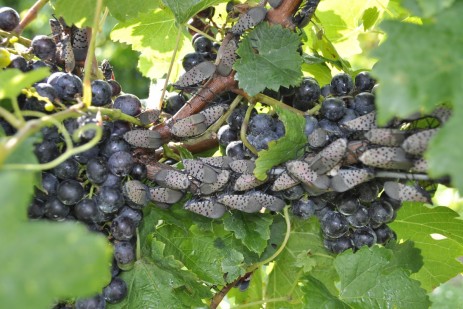May 27, 2021Spotted lanternfly: It’s time to be on the lookout in New York vineyards
The first detection of established spotted lanternfly (Lycorma delicatula) populations in New York was one among many of the ominous events of 2020.
We’ve been monitoring for this pest for a while, but now that it is in the state and closer to our grape production areas, it is time to step up on-farm surveillance. It’s important that we all do our part because prompt detection is key for possible containment and early management.
Vineyard managers will want to be on the lookout and engage all levels of employees who work in the field. We don’t want anyone to miss it so it’s important that we familiarize ourselves with all life stages – some excellent resources that can help with just that are available in both English and Spanish.
Currently, spotted lanternfly (SLF) is widely distributed on New York’s Staten Island while smaller populations are present in both Kings and Queens counties (New York City). In the lower Hudson Valley additional populations have been detected in both Rockland and Orange Counties. The biggest surprise of the year was the detection of a population in the Finger Lakes, with egg masses that were discovered in Ithaca in November of 2020.


How did spotted lanternfly get to all these places in New York?
We may never know for sure, but the SLF is often first found along transportation corridors. Notably, three of the New York finds began near parking areas frequented by out-of-state vehicles.
In the late summer and early fall in regions where the SLF is now well established it’s not unusual to see large numbers of the adults flying about. These adult SLF can easily get into or lay eggs on vehicles and if those vehicles travel to an uninfested region the potential is there for spread. And in the dormant season when the adults have been killed by frost the egg masses can travel with all kinds of materials on which they’ve been laid and can also become unintended cargo.


What to look for depends on when you’re looking. As a reminder the egg masses, which will be hatching in the coming weeks, are shades of tan and can be found on tree bark, stones, rusty metal, lawn furniture and just about anything else. The tiny crawling black nymphs emerge from the egg cases and often feed on shrubby material that’s lower to the ground, so this stage may largely go unnoticed. As they develop through the summer, they become larger and eventually develop prominent red markings. Then in the late summer and early fall the adults begin to appear.
These inch-long adults with polka dotted outer wings and bright-orange underwings are hard to miss when they occur in large numbers. However, when there are just a few, they can be surprising well camouflaged. Keep an eye on trees surrounding the vineyard especially if any of their favorite hosts such as Ailanthus (tree of heaven) or black walnut trees are in the mix. When SLF is new to an area, it is likely that we’ll see it on one of these species of trees first.
If you do see something suspicious take photos and report it here. You’ll receive an immediate response and NYS Agriculture and Markets Staff will follow up.
We’re getting ready
Specialists at Cornell University and Cornell Cooperative Extension have established a list of products that can be used for spotted lanternfly management. This list is specifically for grape production and will be updated as labels change and new materials become available. Note that it will likely take time for SLF populations to build to levels in New York vineyards that require chemical control. As such, grape growers have some time to get a pest management strategy organized if SLF is found in or near their vineyards
– Brian Eshenaur is an IPM educator for Cornell University, Integrated Pest Management Program. Greg Loeb is entomology professor and researcher at Cornell AgriTech/Appellation Cornell















